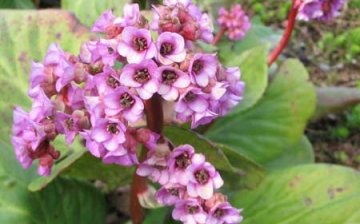Growing badan in the garden
Badan is a perennial plant with thick leathery leaves and bell-shaped flowers, collected in a panicle-thyroid inflorescence of white, purple, red or pink color. Flowering occurs in April-June, 35-40 days in total. Thick, leathery leaves emerge directly from under the snow. Growing badan is often cultivated not only because of its spectacular appearance. This plant has medicinal properties, in particular, antimicrobial, hemostatic, anti-inflammatory, astringent. The leaves of the plant are collected, dried, and then brewed like tea.
Badan is a fairly unpretentious perennial, growing badan is within the power of a novice florist. Seeds are sown before winter directly into the ground, choosing a slightly shaded place (best of all - partial shade). In a brightly lit area, the plant blooms poorly, and in the shade it does not bloom at all. The soil should be loose. You can also plant the plant in the spring, but then you need to use the seedling method. At the end of summer, you can also use the division of the bush, this method is preferable, but for this you need to have something to divide.
The plant must be periodically watered, loosened, weeded, fed with fertilizers for flowers. In the first year, the seedlings are shaded. For the winter, young seedlings are mulched with peat, in the second year this is no longer required. The plant is hardy and does not require shelter for the winter. It usually blooms in the third year, and sometimes only in the fourth. After flowering, the fruit-box is formed. If you do not plan to collect seeds, it is better to cut out the faded flower stalks.




A slightly crumpled fresh berry leaf can be applied to a bruise or wound, here in its properties it can be compared with plantain.